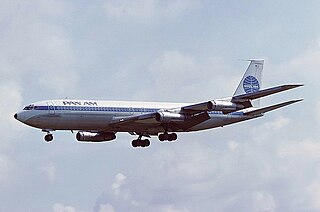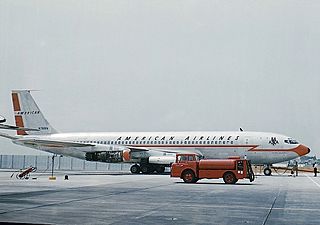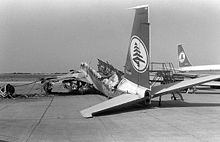
The Boeing 707 is an early American long-range narrow-body airliner, the first jetliner developed and produced by Boeing Commercial Airplanes. Developed from the Boeing 367-80 prototype first flown in 1954, the initial 707-120 first flew on December 20, 1957. Pan Am began regular 707 service on October 26, 1958. With versions produced until 1979, the 707 was a swept wing quadjet with podded engines. Its larger fuselage cross-section allowed six-abreast economy seating, retained in the later 720, 727, 737, and 757 models.

The Boeing 727 is an American narrow-body airliner that was developed and produced by Boeing Commercial Airplanes. After the heavier 707 quad-jet was introduced in 1958, Boeing addressed the demand for shorter flight lengths from smaller airports. On December 5, 1960, the 727 was launched with 40 orders each from United Airlines and Eastern Air Lines. The first 727-100 rolled out on November 27, 1962, first flew on February 9, 1963, and entered service with Eastern on February 1, 1964.

The Douglas DC-8 is an early long-range narrow-body jetliner designed and produced by the American Douglas Aircraft Company. Work began in 1952 towards the United States Air Force's (USAF) requirement for a jet-powered aerial refueling tanker. After losing the USAF's tanker competition to the rival Boeing KC-135 Stratotanker in May 1954, Douglas announced in June 1955 its derived jetliner project marketed to civil operators. In October 1955, Pan Am made the first order along with the competing Boeing 707, and many other airlines soon followed. The first DC-8 was rolled out in Long Beach Airport on April 9, 1958, and flew for the first time on May 30. Following Federal Aviation Administration (FAA) certification in August 1959, the DC-8 entered service with Delta Air Lines on September 18.

A jet airliner or jetliner is an airliner powered by jet engines. Airliners usually have two or four jet engines; three-engined designs were popular in the 1970s but are less common today. Airliners are commonly classified as either the large wide-body aircraft, medium narrow-body aircraft and smaller regional jet.

The Convair 990 Coronado was an American narrow-body four-engined jet airliner produced between 1961 and 1963 by the Convair division of American company General Dynamics. It was a stretched version of its earlier Convair 880 produced in response to a request from American Airlines: the 990 was lengthened by 10 ft (3.0 m), which increased the number of passengers from between 88 and 110 in the 880 to between 96 and 121. This was still fewer passengers than the contemporary Boeing 707 or Douglas DC-8, although the 990 was 25–35 mph (40–56 km/h) faster than either in cruise.

The Rolls-Royce RB.80 Conway was the first turbofan jet engine to enter service. Development started at Rolls-Royce in the 1940s, but the design was used only briefly, in the late 1950s and early 1960s, before other turbofan designs replaced it. The Conway engine was used on versions of the Handley Page Victor, Vickers VC10, Boeing 707-420 and Douglas DC-8-40.

The Pratt & Whitney JT3D is an early turbofan aircraft engine derived from the Pratt & Whitney JT3C. It was first run in 1958 and was first flown in 1959 under a B-45 Tornado test aircraft. Over 8,000 JT3Ds were produced between 1959 and 1985. Most JT3D engines still in service today are used on military aircraft, where the engine is referred to by its US military designation of TF33.

The Boeing C-135 Stratolifter is a transport aircraft derived from the prototype Boeing 367-80 jet airliner in the early 1950s. It has a narrower fuselage and is shorter than the 707. Boeing gave the aircraft the internal designation of Model 717. Since the first one was built in August 1956, the C-135 and its variants have been a fixture of the United States Air Force.
Middle East Airlines – Air Liban S.A.L., more commonly known as Middle East Airlines (MEA), is the flag carrier of Lebanon, with its head office in Beirut, near Beirut–Rafic Hariri International Airport. It operates scheduled international flights to Asia, Europe, the Middle East, and Africa from its base at Rafic Hariri International Airport.

The Pratt & Whitney J75 is an axial-flow turbojet engine first flown in 1955. A two-spool design in the 17,000 lbf (76 kN) thrust class, the J75 was essentially the bigger brother of the Pratt & Whitney J57 (JT3C). It was known in civilian service as the JT4A, and in a variety of stationary roles as the GG4 and FT4.

Somali Airlines was the flag carrier of Somalia. Established in 1964, it offered flights to both domestic and international destinations. It operated Boeing 720Bs, Boeing 707-300s and Airbus A310-300s on a network to the Middle East and Europe. The airline discontinued operations after the start of the civil war in the early 1990s, when the country fell into anarchy. A reconstituted Somali government later began preparations in 2012 for an expected relaunch of the carrier, with the first new Somali Airlines aircraft scheduled for delivery by the end of December 2013.

The Boeing 367-80 is a retired American four-engined jet prototype aircraft built by Boeing to demonstrate the advantages of jet propulsion for commercial aviation. It served as basis for the design of the KC-135 tanker and the 707 airliner.

The General Electric CJ805 is a jet engine which was developed by General Electric Aircraft Engines in the late 1950s. It was a civilian version of the J79 and differed only in detail. It was developed in two versions. The basic CJ805-3 was a turbojet and powered the Convair 880 airliner, while CJ805-23, a turbofan derivative, powered the Convair 990 Coronado variant.

Pakistan International Airlines Flight 705 (PK705) was a Boeing 720 airliner that crashed while descending to land at Cairo International Airport on 20 May 1965. Of the 127 passengers and crew on board, all but 6 were killed.

Middle East Airlines Flight 438 was an international passenger flight operated by a Boeing 720 from Beirut, Lebanon, to Muscat, Oman, with a stopover in Abu Dhabi, United Arab Emirates. On 1 January 1976 the aircraft operating the flight was destroyed by a bomb, killing all 81 people on board. The bombers were never identified.

On September 8, 1974, a Boeing 707-331B operating as TWA Flight 841 from Tel Aviv to New York City via Athens and Rome crashed into the Ionian Sea, killing all aboard. The National Transportation Safety Board determined that the plane had been destroyed by a bomb hidden in the cargo hold. The detonation of the bomb destroyed the systems responsible for operating the plane's control surfaces, causing the plane to pitch up until it stalled and dove into the sea.
Tempair International Airlines Ltd, more commonly known as Tempair, was a UK-based aircraft lease operator, founded in 1972. The airline was headquartered in Windsor, Berkshire. Mounting financial difficulties led to the liquidation of the company in late 1976.

American Airlines Flight 1502 was a crew training flight from Idlewild International Airport. On January 28, 1961, the Boeing 707 operating the flight crashed out of control into the Atlantic Ocean 9.5 miles (15.3 km) west of Montauk Point, New York, and all six crew on board were killed. The cause of the crash was never officially determined. Flight 1502 would be the second of three 707s that American lost in a three-year period in the New York area.

China Airlines Flight 811 was a flight that crash-landed in Manila International Airport on February 27, 1980.
























